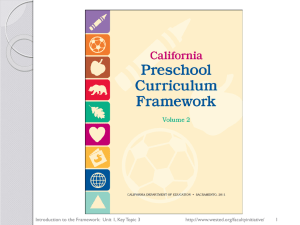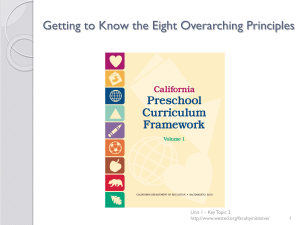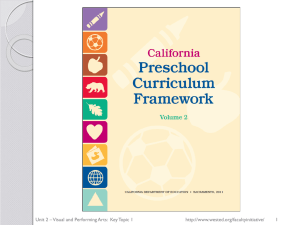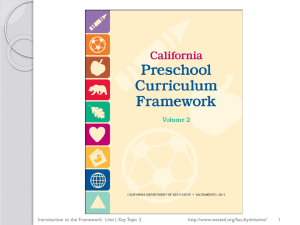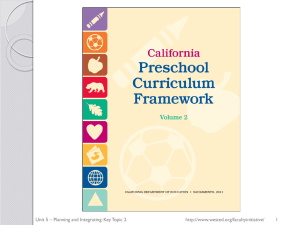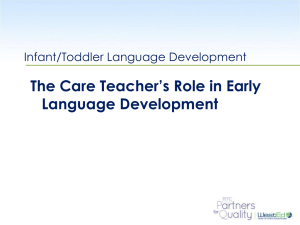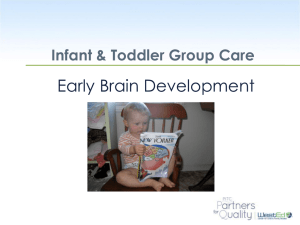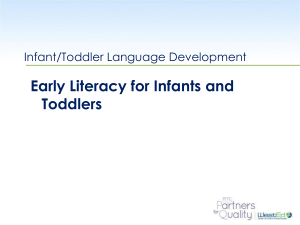Full of the Companion PowerPoint
advertisement
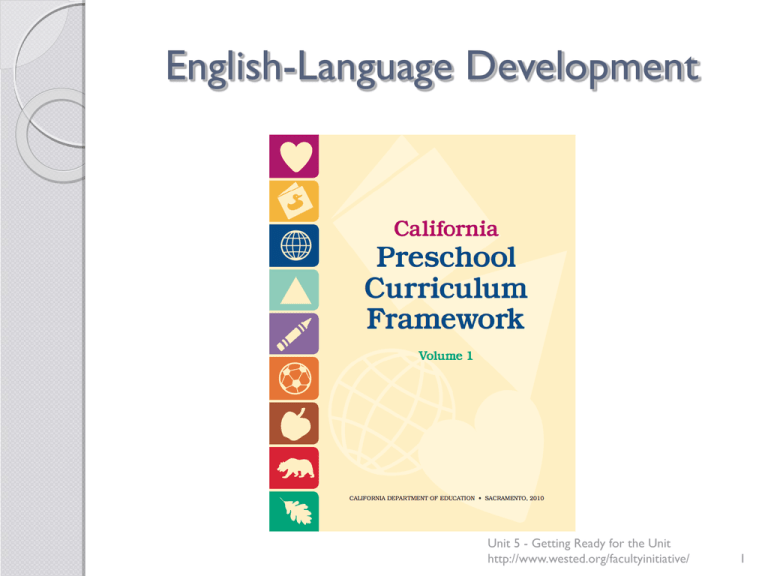
English-Language Development Unit 5 - Getting Ready for the Unit http://www.wested.org/facultyinitiative/ 1 What was the story about? What clues did you get about what was happening in the story? What was this experience like for you? How could you be supported in that experience to link your own language with the language of the story? What does this tell you about the importance of connecting the home and school languages of children who are English learners? Unit 5 - Getting Ready for the Unit http://www.wested.org/facultyinitiative/ 2 Organization and Rationale of the English-Language Development Domain Unit 5 - Key Topic 1 http://www.wested.org/facultyinitiative/ 1 Rationale for the English-Language Development Domain “Preschool programs can best support young children by planning curriculum that fosters English-language development and keeps the children connected to the language of their families” (PCF, V1, p. 5). http://www.wested.org/facultyinitiative/ 2 In 2008, it was estimated that 42 percent of five-year-old children in California were English learners. About 85 percent of these children speak Spanish at home, but many other languages are spoken as well (PCF, V1, p. 4). Unit 5 - Key Topic 1 http://www.wested.org/facultyinitiative/ 3 The strategies described in the California Preschool Curriculum Framework, Volume 1 are applicable and essential for all preschool children, including those who are English learners. However, many young children who are English learners will need adaptations as they are developing their proficiency with the English language (PCF, V1, pp. 178-179). Unit 5 - Key Topic 1 http://www.wested.org/facultyinitiative/ 4 Stages of Second-Language Development ① First stage. The child uses her home language to try to communicate. ② Second stage. The child figures out that he is not successful using the home language with English speakers, so he passes through a period of observation and listening. ③ Third stage. The child attempts to use English in a more abbreviated form through the use of oneword sentences or phrases. ④ Fourth stage. The young child begins to use more elaborated phrases and short sentences to Unit 5 - Key Topic 1 communicate in English. http://www.wested.org/facultyinitiative/ 5 Organization of the English-Language Development Domain Domain Guiding Principles Environments and Materials Cultural Context of Learning Stages of Second-Language Development Assessment Approaches for English Learners Summary of the Strands Summary of the Strands and Substrands Strands: Listening, Speaking, Reading, Writing Substrands in each strand Engaging Families Unit 5 - Key Topic 1 http://www.wested.org/facultyinitiative/ 6 Organization of the English-Language Development Domain Vignettes Teachable moments Suggested interactions and strategies Unit 5 - Key Topic 1 http://www.wested.org/facultyinitiative/ 7 Summary of the Strands and Substrands Listening 1.0 Children Listen with Understanding Speaking 1.0 Children Use Nonverbal and Verbal Strategies to Communicate with Others 2.0 Children Begin to Understand and Use Social Conventions in English 3.0 Children Use Language to Create Oral Narratives About Their Personal Experiences Unit 5 - Key Topic 1 http://www.wested.org/facultyinitiative/ 8 Summary of the Strands and Substrands Reading 1.0 Children Demonstrate Appreciation and Enjoyment of Reading and Literature 2.0 Children Show an Increasing Understanding of Book Reading 3.0 Children Demonstrate an Understanding of Print Conventions 4.0 Children Demonstrate Awareness That Print Carries Meaning 5.0 Children Demonstrate Progress in Their Knowledge of the Alphabet in English 6.0 Children Demonstrate Phonological Awareness Unit 5 - Key Topic 1 http://www.wested.org/facultyinitiative/ 9 Summary of the Strands and Substrands Writing 1.0 Children Use Writing to Communicate Their Ideas http://www.wested.org/facultyinitiative/ 10 Rationale of the English-Language Development Domain Cultural Context of Learning (PCF, V1, 185) Stages of Second-Language Development (PCF, V1, pp. 185-186) Assessment Approaches for Preschool English Learners (PCF, V1, pp. 186-187) Unit 5 - Key Topic 1 http://www.wested.org/facultyinitiative/ p. 11 What ideas stood out for you in looking at the organization of this domain? How will these influence your work in early care and education? What else would you like to know about how to support children in Englishlanguage development? Unit 5 - Key Topic 1 http://www.wested.org/facultyinitiative/ 12 Getting to Know Environments and Materials That Support English-Language Development Unit 5 - Key Topic 2 http://www.wested.org/facultyinitiative/ 1 Domain Guiding Principles Families matter. Recognize exiting language and literacy strengths in the home language. Respect cultural values and behaviors reflected in the child’s language and communication. Allow the child use of the home language to have immediate access to the entire curriculum, concept development, and high levels of interaction. Unit 5 - Key Topic 2 http://www.wested.org/facultyinitiative/ 2 Domain Guiding Principles Support English-language development across all domains. Use language as a meaningful tool to communicate. Make children’s learning interesting and fun for English learners. Accept code switching as normal. Give preschool English learners their time. Allow for children’s voluntary participation. Unit 5 - Key Topic 2 http://www.wested.org/facultyinitiative/ 3 Environments and Materials Provide safe havens where the child does not have to speak to anyone. Establish consistent classroom routines and procedures. Provide space in the classroom environment for children to interact in small groups and one-on-one. Unit 5 - Key Topic 2 http://www.wested.org/facultyinitiative/ 4 Environments and Materials Provide space where teachers and other adults can interact individually and in small groups with children who are learning English. Provide linguistically and culturally appropriate materials. Make clear signs and explicit picture cues for interest areas. Make use of computers to introduce and reinforce content of activities. Unit 5 - Key Topic 2 http://www.wested.org/facultyinitiative/ 5 What new insights emerged as you went through this exercise? How might these insights affect your work with young children now or in the future? Unit 5 - Key Topic 2 http://www.wested.org/facultyinitiative/ 6 Compare the principles included in both the: Preschool English Learners: Principles and Practices to Promote Language, Literacy, and Learning, 2nd ed. English-language development domain of the California Preschool Curriculum Framework, Volume 1 Unit 5 - Key Topic 2 http://www.wested.org/facultyinitiative/ 7 Where are they similar? Where are they different? What is in one that is not in the other? What might account for that? How could these principles be used to guide curriculum planning? Unit 5 - Key Topic 2 http://www.wested.org/facultyinitiative/ 8 Getting to Know Interactions and Strategies That Support English-Language Development Unit 5 - Key Topic 3 http://www.wested.org/facultyinitiative/ 1 Summary of the Strands and Substrands Listening 1.0 Children Listen with Understanding Speaking 1.0 Children Use Nonverbal and Verbal Strategies to Communicate with Others 2.0 Children Begin to Understand and Use Social Conventions in English 3.0 Children Use Language to Create Oral Narratives About Their Personal Experiences Unit 5 - Key Topic 3 http://www.wested.org/facultyinitiative/ 2 Summary of the Strands and Substrands Reading 1.0 Children Demonstrate Appreciation and Enjoyment of Reading and Literature 2.0 Children Show an Increasing Understanding of Book Reading 3.0 Children Demonstrate an Understanding of Print Conventions 4.0 Children Demonstrate Awareness That Print Carries Meaning 5.0 Children Demonstrate Progress in Their Knowledge of the Alphabet in English 6.0 Children Demonstrate Phonological Awareness Unit 5 - Key Topic 3 http://www.wested.org/facultyinitiative/ 3 Summary of the Strands and Substrands Writing 1.0 Children Use Writing to Communicate Their Ideas http://www.wested.org/facultyinitiative/ 4 Listening How does the teacher do this in the vignette? If a particular interaction or strategy could not be found in the vignette, how would doing it help Lonia as she develops her ability to attend to and comprehend spoken English? Unit 5 - Key Topic 3 http://www.wested.org/facultyinitiative/ 5 Speaking Which of the interactions and strategies from the Speaking strand can you find in this vignette? How would Ms. Jane have known what kind of language interactions would be appropriate for Enrique? Unit 5 - Key Topic 3 http://www.wested.org/facultyinitiative/ 6 Reading How does each of the key points connect to this substrand—either in the vignette or the interactions and strategies? In each vignette, what did the teacher see or hear that helped him understand what skills the children might have in their home language that could be built upon to develop skills in English? Unit 5 - Key Topic 3 http://www.wested.org/facultyinitiative/ 7 Writing How does the teacher do this in the vignette? If a particular interaction or strategy could not be found in the vignette, how could this vignette be extended to incorporate that interaction or strategy into this vignette? Unit 5 - Key Topic 3 http://www.wested.org/facultyinitiative/ 8 What stood out for you in this key topic? What new insights do you have? How will this influence your work with young children now or in the future? If you had to come up with two statements to describe to someone what is important in working with young children who are English learners, what would they be? Unit 5 - Key Topic 3 http://www.wested.org/facultyinitiative/ 9 Preschool English Learners: Principles and Practices to Promote Language, Literacy, and Learning, 2nd ed. Chapter 5: “Stages and Strategies in Second-Language Acquisition” Unit 5 - Key Topic 3 http://www.wested.org/facultyinitiative/ 10 The Intentional Teacher (Epstein, 2007) • Read pages 14-18 • Consider how the English-language development interactions and strategies could be linked to the strategies presented by Epstein. • Develop a list of Epstein’s core strategies and, under each strategy, list at least 3 Englishlanguage development strategies that could be used to include the needs of English learners. • Write a short paragraph explaining your decisions. Unit 5 - Key Topic 3 http://www.wested.org/facultyinitiative/ 11 Universal Design, Individualizing, and Family Partnerships Unit 5 - Key Topic 4 http://www.wested.org/facultyinitiative/ 1 Universal Design Multiple means of representation Multiple means of expression Multiple means of engagement Unit 5 - Key Topic 4 http://www.wested.org/facultyinitiative/ 2 Universal Design What are some of the key concepts in universal design? Which concepts were clear to you? Which concepts were confusing? What other questions do you have about universal design related to children who are English learners? What resources do you think would be most helpful to you in your work? Unit 5 - Key Topic 4 http://www.wested.org/facultyinitiative/ 3 Universal Design What information from the presenter(s) caught your attention or stood out for you? What are you most confident about in supporting children who are English learners and also have an identified language delay or disability? What concerns you? What new or different perspectives do you have? How has this discussion been helpful? Unit 5 - Key Topic 4 http://www.wested.org/facultyinitiative/ 4 “Individualization of learning includes all children” Unit 5 - Key Topic 4 http://www.wested.org/facultyinitiative/ 5 Individualizing What kinds of documentation could you use to help understand individual children in terms of their English-language development? What are some ways you could get to know the families of individual children? How could you learn about the child’s language and community? Unit 5 - Key Topic 4 http://www.wested.org/facultyinitiative/ 6 Individualizing How could you find out what things a child is interested in? What different kinds of information about a child could you obtain by observing during different parts of the daily routine? What are some ways you could determine each child’s strengths in his home language? Unit 5 - Key Topic 4 http://www.wested.org/facultyinitiative/ 7 Family Partnerships What considerations or ideas about the influence of families on children’s Englishlanguage development caught your attention? Which ones resonated with you because of your experiences with children and families? Unit 5 - Key Topic 4 http://www.wested.org/facultyinitiative/ 8 Family Partnerships Which strategies or interactions do you think are most important to include in order to build strong partnerships with families that foster children’s Englishlanguage development? What is a first step you would take in building these partnerships? Unit 5 - Key Topic 4 http://www.wested.org/facultyinitiative/ 9 What ideas stood out most for you today? Which ones reinforced what you have already learned or experienced? Which ones gave you a new perspective or insight? How might you apply a new perspective to your work now or in the future? What further information or support do you need? What first step do you need to do? Unit 5 - Key Topic 4 http://www.wested.org/facultyinitiative/ 10
